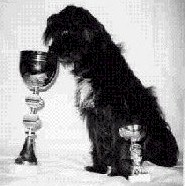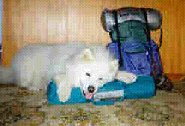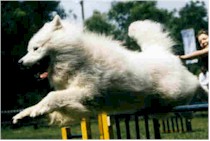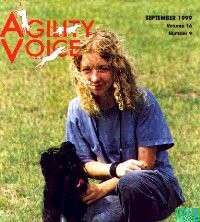| |
It's a small, small world
 In
Slovenia, everything is near. The furthest competition is two hours of driving away. It's a
small country, located between Italy and Austria, population of 2 million, with something over
100 crazy souls called 'agility people.' One of those, Silvia Trkman, tells about agility in
Slovenia... In
Slovenia, everything is near. The furthest competition is two hours of driving away. It's a
small country, located between Italy and Austria, population of 2 million, with something over
100 crazy souls called 'agility people.' One of those, Silvia Trkman, tells about agility in
Slovenia...
In
Slovenia, everything is near. The furthest competition is two hours of driving away. It's a
small country, located between Italy and Austria, with population of two million and with
something over 100 of those crazy people, called agility people. Being one of those, Silvia
Trkman tells about agility in Slovenia…
The first presentation
of agility in Slovenia was in 1989 - though back then, it didn't look much like agility as we
know it now. The dogs mostly came from classic IPO (Schutzhund + obedience + tracking) training
and were running along side their handlers on the left side. They tried their best on the
obstacles that they mostly saw only at so called 'competitions'.
 Agility - sport of many breeds
Agility - sport of many breeds
Nine years later, the FCI entrusted Slovenia to organise World Agility Championship that were
held October 1998 in Maribor. Today there are more than 100 dogs competing regularly. Most of
them were bought as family dogs and got infected by agility virus later, so you can see all
breeds of dogs competing. Most common in standard dogs include German Shepherd Dogs, Belgian
Malinois, Retrievers, Setters, while Minis include Poodles, English Cockers, Spitz and small
Mongrels.
The first dogs, bought with agility in mind, appeared just a couple of years ago and since
then, the number of Border Collies has been growing too. Before agility began, believe it or
not, there were no Border Collies in whole country. Now, however, we've imported BCs from
England, Belgium, Italy, Germany and Croatia and had several litters, so we have more and more
BCs every year. All the dogs are pretty young, the first Border Collie ran in our Team in the
World Championships in 2000. We've been sending a Samoyed, an American Staffordshire Terrier, a
Dalmatian, Retrievers and other breeds, not often seen in agility, to WCs.
That's probably why we don't have many high placements from World
Championships, since you can't do much without a BC in WC. According to statistics, only BCs,
Tervuerens and one Epagnuel Breton and one Beauceron were among top three in WC in all the
years it exists. The fact that in Slovenia, National Champion in 1998 was a Samoyed (not
ordinary Samoyed though: he is mine), tells a lot. But I think it's nice to see dogs of all
breeds enjoying and even winning in agility.
We have been sending teams to the European Championships (which became
the World Championship in 1996) from early beginnings of the competition in 1992. More and more
countries are presented every year and the quality and the speed of the dogs grow
scientifically from year to year too.
Slovenia's best individual showing is fifth place at the 2000 World
Championship in Helsinki, Finland, achieved by the author and her Pyrenean Shepherd in mini
class.
 FCI rules
FCI rules
For those not familiar with the WC,
it's run in two height classes; Mini for dogs under 40cm that jump 35-40cm and Standard for
dogs over 40cm that jump 55-65 cm. Every country can send four Minis and four Standards which
are selected differently in different countries. In Slovenia, we have 6 qualification
competitions, four best results from which count and those four who place the highest in four
of those 6 competitions get to go to World Championships. The Team for Portugal 2001 is not
completely known, my money is on one BC, one Labrador and two Belgians in Standard and Pyrenean
Shepherd and 2 Poodles in Mini.
We don't have that large number of agility people to choose from than other countries,
but the quality is constantly growing, so we have all the reasons to stay optimistic.
Living in a small country also has its advantages. We can be at every
competition in Slovenia with no more than two hours travelling time, within five hours of
driving you can be on competition every weekend and within 10 hours of driving you can be
almost anywhere in Europe. I've competed in 13 different European countries with my dogs. It's
also the other way around: we have people from Croatia, Italy and Austria regularly competing
in Slovenia.
 We
have around twenty competitions every year. Ten count towards the National Championship of
which six are qualifiers for the World Championship Team. Six are for the trophy and the others
are competitions for various cups and trophies. We
have around twenty competitions every year. Ten count towards the National Championship of
which six are qualifiers for the World Championship Team. Six are for the trophy and the others
are competitions for various cups and trophies.
The number of competitions and qualifying system is determined by the governing body the
Kinoloska Zveza Slovenije (KZS). It has no influence, however, on the rules on those
competitions. Those are determined by FCI and the same in almost all European countries (with
an exception of France where the judging is the same, but competitions are run in four
different height classes, called A, B, C, D).
There are three levels of classes (A1, A2 and A3). Progress to A2 is possible with
three runs with five or less penalty points, progress to A3 with three placements among top
three with clean run.
So I guess FCI agility is somewhere in between US and UK agility. You can progress with
qualifying (to A2, but not A3), but you're not given any titles, so winning is still the only
thing that counts. In Slovenia, winning is still possible with almost any breed. But if the BC
Boom of the last two or three years continues, it won't be so for long.
World Championship is not everything
World Championship is definitely an event you never forget, but camping at dog clubs all
around Europe has its charm and if you never go to small competitions in small villages, you'll
never meet the nicest people on Earth. Competitions are to me mostly just a good excuse for
travelling Europe, meeting people, making friends and exchanging experiences. I wouldn't trade
that for a win on WC.
The most important part of agility is loving a dog you have and despite I don't see
anything wrong in buying a dog with agility in mind, I'm definitely against buying a dog with
only agility in mind. The only good reason for doing agility is still enjoying working with a
dog we love.
 About the author...
About the author...
Silvia Trkman
is a student of Philosophy and Journalism at the University of Ljubljana.
She has been doing agility for eight years now, starting with her first dog that she got
when she was 11. Aiken was a hard dog to start with, he was very dominant and independent
Samoyed puppy, but with a lot of work, he became the most successful agility Samoyed in the
world ever, he was National Champion in 1998, World Team member in 1997 and 1998 and is best
placed northern dog in WC.
Aiken is retired now, so that Silvia's second dog, four years old Pyrenean Shepherd
Vedette - Lo, does the winning now. She is National champion from 1999 on, World Team member
from 1998 on (she ran her first WC at only 21 months), is best placed Slovenian dog in WC
(fifth place in Helsinki 2000), has wins from 11 different European countries, is International
Agility Champion etc. or in short: one of the best mini dogs in Europe.
e-mail:
janez.trkman@telemach.net, URL:
http://www.geocities.com/sssiaaa/
| |
|